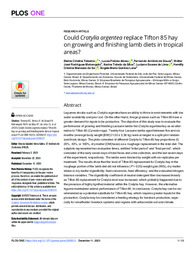Could Cratylia argentea replace Tifton 85 hay on growing and finishing lamb diets in tropical areas?
Could Cratylia argentea replace Tifton 85 hay on growing and finishing lamb diets in tropical areas?
Author(s): TEIXEIRA, E. C.; ABREU, L. F.; SOUZA, F. A. de; MATRANGOLO, W. J. R.; SILVA, K. T. da; LIMA, L. S. de; SA, H. C. M. de; LANA, A. M. Q.
Summary: Legumes shrubs such as Cratylia argentea have an ability to thrive in environments with low water availability and poor soil. On the other hand, forage grasses such as Tifton 85 have a greater demand for inputs to be productive. The objective of this study was to evaluate the performance of growing and finishing Lacaune lambs fed Cratylia argentea hay as an alternative to Tifton 85 (Cynodon spp). Twenty-four Lacaune lambs aged between five and six months (average body weight [BW] 21.50 ± 3.38 kg) were arranged in a split-plot randomized block design. The plots consisted of different Cratylia to Tifton 85 hay proportions (0, 20%, 40%, or 100%, dry matter [DM] basis) as a roughage replacement in the total diet. The subplots represented two evaluation times, entitled “initial period” and “final period”, which consisted of the early seven days of total feces and urine collection, and the last seven days of the experiment, respectively. The lambs were blocked by weight with six replicates per treatment. The results show that the level of Tifton 85 replacement for Cratylia hay in the roughage portion of the lamb diet did not influence (P > 0.05) weight gain (WG), dry matter intake or dry matter digestibility; feed conversion, feed efficiency; and the evaluated nitrogen balance variables. The digestibility coefficient of neutral detergent fiber decreased linearly as Tifton 85 replacement for Cratylia level was increased, which probably happened due to the presence of highly lignified material within the Cratylia hay. However, the alternative legume maintained animal performance of Tifton 85. In conclusion, Cratylia hay can be recommended as a potential substitute for Tifton 85 hay, which requires greater inputs for the production. Cratylia may be considered a feeding strategy for livestock production, especially for smallholder livestock systems and regions with unfavorable soil and climate.
Publication year: 2023
Types of publication: Journal article
Unit: Embrapa Maize & Sorghum
Keywords: Alimentação, Cordeiro, Feno, Gramínea Forrageira, Leguminosa
Observation
Some of Embrapa's publications are published as ePub files. To read them, use or download one of the following free software options to your computer or mobile device. Android: Google Play Books; IOS: iBooks; Windows and Linux: Calibre.
Access other publications
Access the Agricultural Research Database (BDPA) to consult Embrapa's full library collection and records.
Visit Embrapa Bookstore to purchase books and other publications sold by Embrapa.

